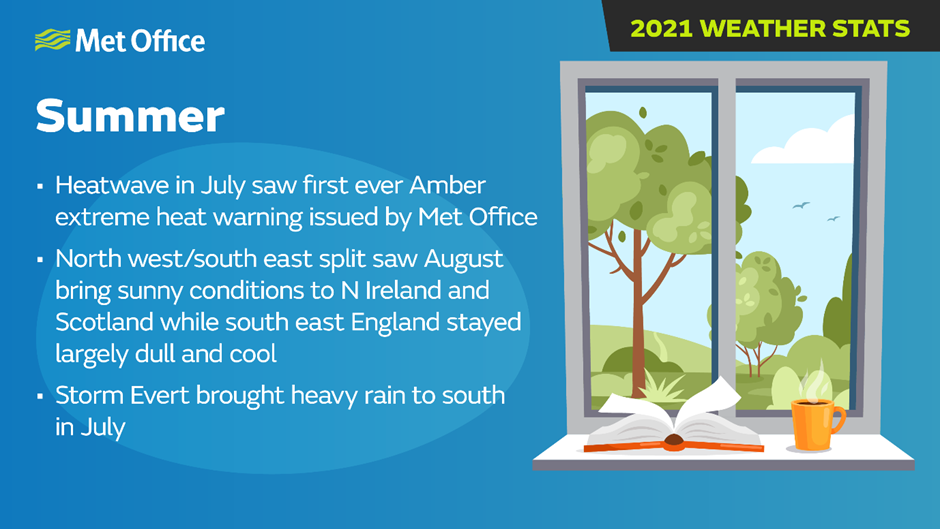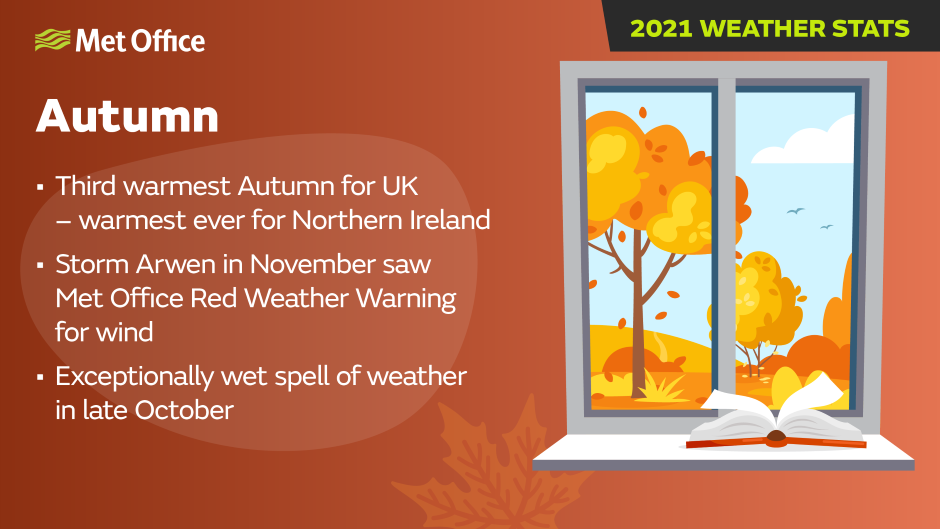2021: the UK's weather in review
Author: Press Office
10:36 (UTC) on Thu 30 Dec 2021
2021 has been less of a record-breaker than 2020, but there has still been plenty of notable weather.
For the UK the overall picture of the year as a whole is fairly ‘average’, with temperature and sunshine levels fairly close to the long-term average and rainfall slightly below.
But what do we mean by ‘average’? 2021 was the first year of a new decade. The Met Office has recently updated to the latest World Meteorological Organization climate averages which are for the period 1991-2020 and, in line with this, the year has been compared against this new period. So, although the UK mean temperature has been close to the ‘average’ compared to 1991-2020, our climate is warming, which means it is closer to 1.0°C warmer than the earlier 1961-1990 baseline, and is likely to fall inside the top 20 warmest years on record for the UK – a series which begins in 1884.
Inevitably, the UK figures mask some regional details. Northern Ireland is likely to finish within the top five warmest years, thanks to unusually warm summer and autumn seasons, including its highest temperature on record, set during July. North-western parts of the UK have seen sunshine statistics well above average, and rainfall well below average.
Regional variation
Mike Kendon is from the Met Office National Climate Information Centre. He said: “Overall, it has been a fairly unremarkable year in terms of annual statistics. The UK as a whole has been slightly warmer and slightly drier than average, though with some variation around the country especially regarding rainfall.
“Broadly speaking, colder than average conditions dominated through the early part of the year, but most months have been warmer than average from June to December, September being the most notable of these. The wettest month relative to average was May, and we had unusually dry weather predominating in April, June – except in the south-east - and November, except for the far north-west. For the second year in a row, April was exceptionally sunny across the UK, and it also had the most air frosts for at least 60 years.” The Met Office air frost series began in 1960. An air frost occurs when the air temperature dips below 0.0°C.
Seasonal headlines
Winter 2020/21

- The UK’s coldest January since 2010
- -23.0°C at Braemar, in Aberdeenshire, on 11 February; the UK’s lowest temperature since 1995
- Exceptionally wet weather from Storm Christoph in January
- A bitterly cold easterly spell and including snow from Storm Darcy in early February.
- Winter as a whole was colder and wetter than average
Spring 2021

- A notably dry and very sunny April, the sunniest April on record for the UK, with the most air frosts for at least 60 years.
- The wettest May on record in Wales, fifth wettest for England and fourth wettest for the UK overall.
- An unseasonably warm spell at the end of March reaching 24.5°C at Kew.
- A cool spring overall (1.0C below the 1991-2020 average) but sunnier than average.
Summer 2021

- A heatwave in July saw the first ever Amber extreme heat warning issued by Met Office
- 31.3°C at Castlederg, County Tyrone on 21st July: Northern Ireland’s highest temperature on record.
- The third warmest summer on record for Northern Ireland and ninth warmest for the UK overall.
- The north-west/south-east split resulted in often sunnier conditions in Northern Ireland and Scotland while for South East England the summer was wetter and duller than average.
- Storm Evert, the UK’s first named storm to occur in July, brought heavy rain to the south in July and unusually strong winds for the time of year.
Autumn 2021

- It was the third warmest autumn for UK and the warmest on record for Northern Ireland
- Two rain-gauges in the Lake District recorded daily totals of over 200mm during an exceptionally wet spell of weather in late October. Weather patterns were very similar to those seen during the exceptional rainfall of December 2015 and November 2009.
- Storm Arwen in November saw a Met Office Red weather warning for wind along the north east coast, one of the most powerful and damaging storms of the latest decade.
An update to the 2021 UK climate statistics will be published early in 2022.





